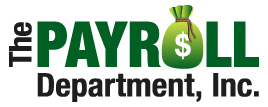Do You Know the Difference Between Payroll Expense and Cost of Labor?
Did you know that the cost of labor can be one of the largest expenses a small business can have? It’s second only to the cost of real estate, according to the U.S. Department of Labor. Depending upon the industry you’re in, labor costs can range from 10% to 30% – or more. For your small business, your labor costs can quickly eat up your earnings if they’re not monitored and adjusted accordingly.
 At The Payroll Department, we’re found that managing payroll expenses can be a difficult aspect for some small business owners when it comes running a business. Plus, several business owners have trouble determining the price of their products when it comes to their cost of labor and other expenses. Therefore, we want to take this opportunity to answer some basic questions small business owners may have about payroll expense and cost of labor.
At The Payroll Department, we’re found that managing payroll expenses can be a difficult aspect for some small business owners when it comes running a business. Plus, several business owners have trouble determining the price of their products when it comes to their cost of labor and other expenses. Therefore, we want to take this opportunity to answer some basic questions small business owners may have about payroll expense and cost of labor.
What Is Payroll Expense?
Payroll expense is the amount you pay to your employees in the form of salaries and wages in exchange for the work they do for your business. Any compensation you give to your employees should be included as a payroll expense, including bonuses, stock options, commissions, and other money spent on your employees.
Additionally, any benefits you provide your employers are also a payroll expense. The payroll expense is the portion you pay for your employees’ health care plans and/or retirement funds.
Furthermore, it also includes the amount your business pays in taxes to federal, state, and local agencies based on gross payroll figures. However, the tax withholdings from employee paychecks are not included in your payroll expenses since they’ve already been included as part of gross wages.
What Is Cost of Labor?
The cost of labor is the total amount of all salaries, wages, and other forms of income paid to employees. It also includes the total amounts of all employee benefits and federal, state, and local payroll taxes that your business has paid (not the portion your employees paid).
The cost of labor is broken into direct and indirect (overhead) costs. Direct labor costs are those expenses that are directly related to product production. Direct costs include the wages of employees who directly make the product. Indirect labor costs are those expenses related to supporting product production. Indirect costs would include the wages of office workers, security personnel, or employees who maintain factory equipment. The work they provide isn’t directly related to producing a product.
Unlike payroll expense, the cost of labor also includes the amounts paid to contract labor. An independent contractor (also called a freelancer) provides work for your business when needed, but they are not an employee. They are paid on a contract basis, using an IRS Form 1099 to report the payments.
Why Is It Important to Know the Difference Between the Two?
Since payroll expenses can be a significant expense for your business, you must know how to manage your payroll expenditures shrewdly. Equally, if you don’t understand all the expenses related to your business, your cost of labor can grow out of control.
Another reason is your cost of labor (plus your material and overhead costs) needs to be factored into your product prices. If you don’t include the total costs incurred by your company in your sales price, the amount of profit you make will be lower than you expect. Also, if customer demand for your products declines, or a competitor forces you to cut your prices, you will have to reduce your cost of labor if you want to stay profitable. In these cases, you would need to reduce your workforce, cancel contracts with contract workers, cut back on your production, or reduce the cost of other direct or indirect items included in the cost of production like raw materials, equipment, etc.
You also need to understand cost of labor if you’re doing job costing, which refers to an accounting method used to track the expenses involved in creating a specific product. Not only does job costing involve looking at your cost of labor, but also at your materials and overhead costs for the job. You would use this accounting method to help you determine if you can reduce costs for future jobs. Or, you may want to bill customers more for any excess costs incurred.
What to Do If You Need Help with Managing Your Payroll Expenses and Cost of Labor
If you require help determining your small business’s payroll expenses and cost of labor, contact The Payroll Department, located in Brownsburg, Indiana. Grace Walker, our experienced bookkeeper, can help you understand how to compute your payroll expenses and cost of labor, so you can make informed decisions when it comes to pricing your products, hiring additional employees or contract workers, or reducing production costs within your business.
For more information about our bookkeeping services, call Teresa Ray, owner of The Payroll Department at 317-852-2568. She’ll be happy to talk with you about your needs and how outsourcing your bookkeeping, as well as your payroll, can benefit your business. With The Payroll Department’s help, you can appropriately manage your payroll expenses and labor costs to keep them under control, so your small business can remain profitable.
– Ariane of The Payroll Department Blog Team

